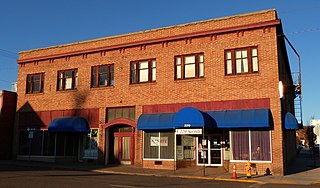Klamath Falls City Hall | |
The Klamath Falls City Hall in 2014 | |
| Location | 226 South 5th Street Klamath Falls, Oregon |
|---|---|
| Coordinates | 42°13′24″N121°46′51″W / 42.22333°N 121.78083°W Coordinates: 42°13′24″N121°46′51″W / 42.22333°N 121.78083°W |
| Area | 0.2 acres (0.081 ha) |
| Built | 1914 |
| Architect | Earl Beach Veghte |
| Architectural style | Beaux Arts |
| NRHP reference # | 89001861 [1] |
| Added to NRHP | October 30, 1989 |
Klamath Falls City Hall is a city hall building in Klamath Falls, Oregon, in the United States. It was built in 1914 and added to the National Register of Historic Places on October 30, 1989. [1]

Klamath Falls is a city in and the county seat of Klamath County, Oregon, United States. The city was originally called Linkville when George Nurse founded the town in 1867. It was named after the Link River, on whose falls the city was sited. The name was changed to Klamath Falls in 1893. The population was 20,840 at the 2010 census. The city is on the southeastern shore of the Upper Klamath Lake and about 25 miles (40 km) north of the California–Oregon border.

The National Register of Historic Places (NRHP) is the United States federal government's official list of districts, sites, buildings, structures, and objects deemed worthy of preservation for their historical significance. A property listed in the National Register, or located within a National Register Historic District, may qualify for tax incentives derived from the total value of expenses incurred preserving the property.
It is a two-and-a-half-story Beaux Arts-style building designed by Earl Veghte, a young architect. [2]
It has four colossal Ionic columns. It has brick and contrasting concrete trim elements, including flat-arched lintels with raised keystones and voussoirs. [2]

The Ionic order forms one of the three classical orders of classical architecture, the other two canonic orders being the Doric and the Corinthian. There are two lesser orders: the Tuscan, and the rich variant of Corinthian called the composite order, both added by 16th-century Italian architectural writers, based on Roman practice. Of the three canonic orders, the Ionic order has the narrowest columns.














